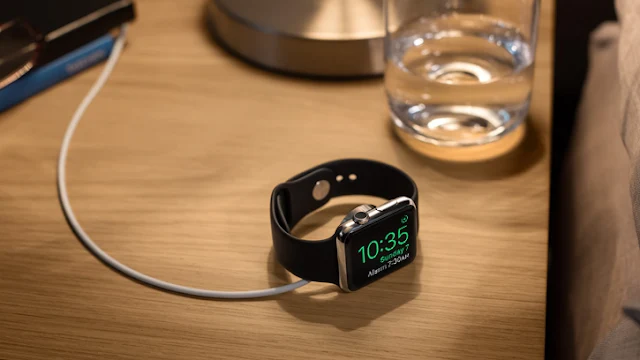Nightstand Mode – A Feature to Replace Bedside Alarm Clock
Some of Apple Watch UI elements seem to be in place like the Home Screen with a network of unlabelled circular icons, while there are other parts of watchOS which have been changed for improvement. For instance, the watchOS 2 has a Nightstand mode which enables the Apple Watch to stay in service as a timepiece while charging.
Nightstand mode is a feature which could replace the bedside alarm clock providing that one prefers turning the Apple Watch into landscape mode to utilise it. Nightstand mode presently has zero configurability and it could either be on or off, where a single switch is adjustable in iOS 9 of Apple Watch setting on a watchOS 2 equipped Apple Watch. To turn on Nightstand mode, you could
- Place the Apple Watch on its side
- Connect the Apple Watch to its charger
- When it starts charging, your Apple Watch will automatically be in Nightstand mode
Chime through Watch’s Integrated Speaker
When the Apple Watch is in Nightstand mode and not in use, the display tends to go off. To view the display again, one could tap it and press the Digital Crown or the side button or lightly push the Apple Watch. Tapping or pushing the table could also work.
When it is on, a battery indicator towards the upper right area is displayed along with a large digital clock having a pulsing colon with the day of week together with the day of month. If the alarm is set, one will see an alarm icon in the upper left area and an additional line of text towards the bottom of the screen indicating that an alarm has been set for a certain time. The screen tends to change when the alarm goes off and a chime is heard through the Watch’s integrated speaker.
Alarm on Apple Watch Different from iPhone
If the `Snooze’ button is pressed, the user tends to return to the Nightstand clock face where the alarm line of text reads `Snoozing’ with a countdown timer of 9 minutes. Presently force touching the screen in Nightstand mode doesnot enable the user to change its appearance or functions, it tends to bounce back to recognize the Force Touch without the need of doing anything. The alarm on Apple Watch seems different from the alarm on the iPhone and one needs to set or adjust the alarm for Nightstand mode from Apple Watch. This can be done by:
- Opening the Alarms app on the Apple Watch
- Pressing firmly the display and tap Add Alarm
- Tap the screen or rotate the Digital Crown to regulate the alarm
When the alarm begins, the apple Watch makes a sound and to turn off the alarm, the side button could be pressed. WatchOS 2 is in its development stage with 6 or 7 consequent betas to go prior to becoming final in the fall and there seems to be adequate time left for improvement of Nightstand before its release.





